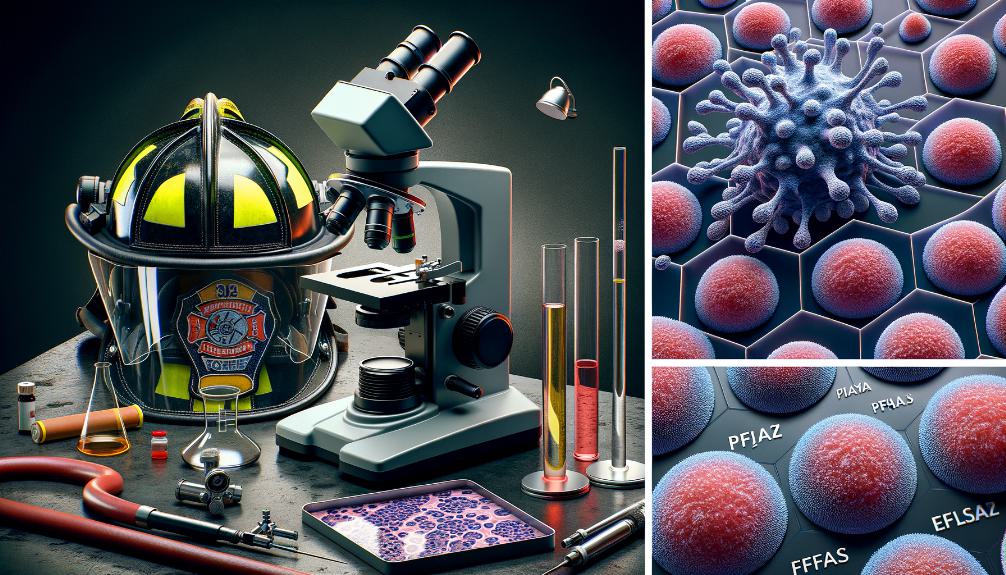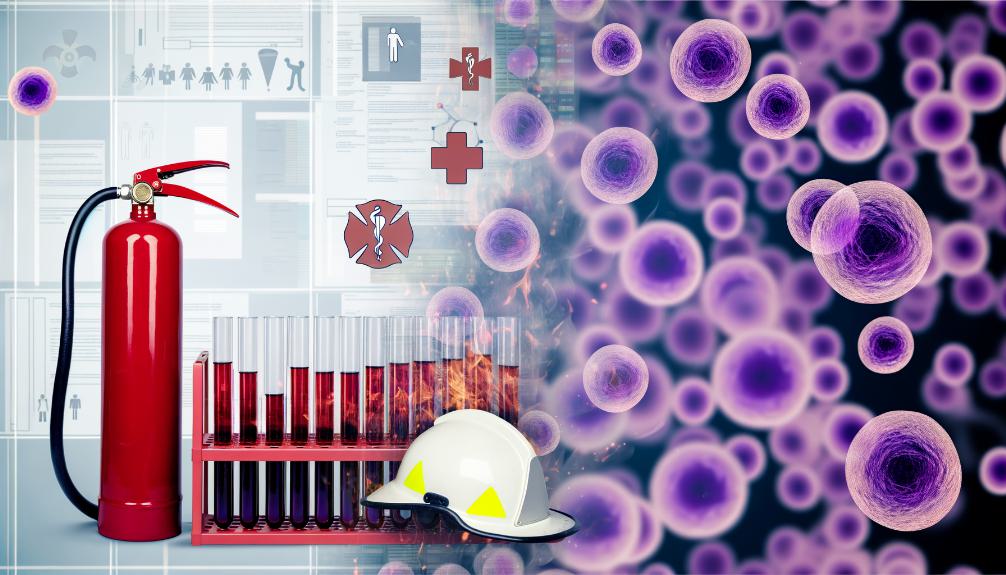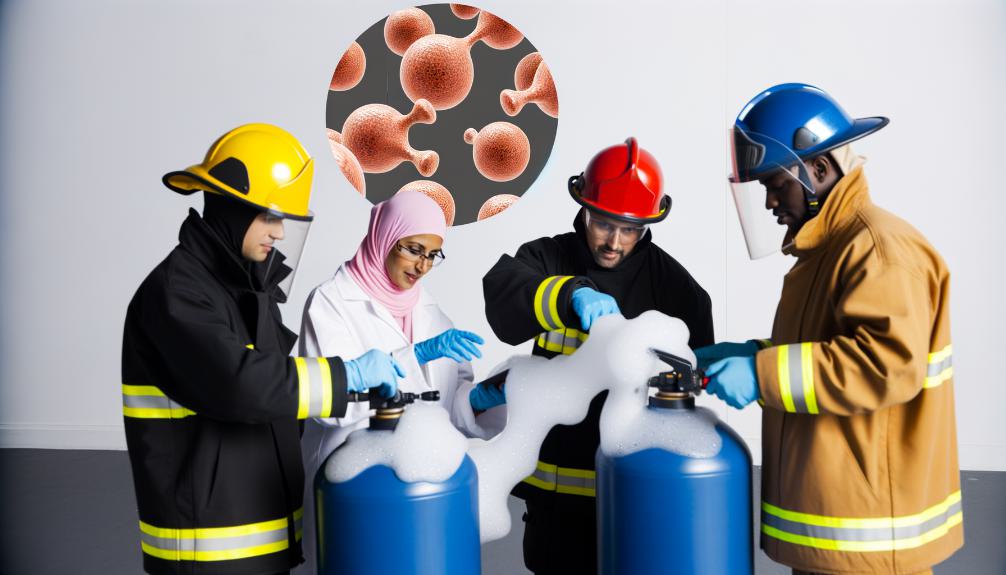Multiple Myeloma: Distinguishing AFFF-Related Cases
We're tackling the challenge of identifying multiple myeloma cases linked to AFFF exposure. Aqueous Film-Forming Foam, or AFFF, contains PFAS chemicals like PFOS and PFOA, associated with a higher risk of developing blood cancers, including multiple myeloma. Firefighters and others in high-risk occupations exposed to AFFF may face elevated levels of PFAS, increasing their cancer risk. Early diagnosis and legal action are important for those affected. Our focus is on prevention, early detection, and support for affected individuals, providing essential insights for minimizing exposure and enhancing safety protocols. Gaining awareness of these key factors could be the answer to safeguarding health.

Key Takeaways
- Documented history of AFFF exposure is critical in distinguishing AFFF-related multiple myeloma cases.
- Elevated PFAS levels in blood tests can indicate AFFF-related origins of multiple myeloma.
- Occupations with high AFFF exposure, like firefighting, are more likely to be linked to AFFF-related multiple myeloma.
- Symptoms unique to PFAS exposure, combined with multiple myeloma diagnosis, may suggest AFFF-related cases.
- Legal and medical records highlighting AFFF exposure times and durations aid in distinguishing AFFF-related multiple myeloma cases.
Understanding AFFF

Aqueous Film-Forming Foam (AFFF) is commonly used to combat fuel fires, but it is important to understand its composition and the health risks posed by its PFAS content. These substances, including PFOS and PFOA, are not only persistent in the environment but also pose significant health risks, especially concerning cancer. When we explore the specifics, the connection between PFAS exposure through AFFF and an increased risk of developing blood cancers, such as Multiple Myeloma, becomes a focal point of concern.
It's significant for us to recognize these risk factors associated with PFAS exposure. Research indicates that the chemicals in AFFF can accumulate in the body over time, leading to a heightened cancer risk. This awareness is crucial for both individuals who have been exposed to AFFF and for the broader community, as it underscores the need for thorough risk assessment and mitigation strategies.
For those of us concerned about health and safety, the link between AFFF use and increased cancer risk, including Multiple Myeloma, requires urgent attention. By acknowledging these risk factors, we can advocate for safer alternatives to AFFF and push for detailed health monitoring for individuals at risk of PFAS exposure. Ultimately, understanding the composition of AFFF and its health implications is a critical step in protecting ourselves and our communities from potential harm.
PFAS Chemicals Overview
We're now turning our attention to the origin of PFAS chemicals and the critical need to assess their health impacts. These substances, central to AFFF firefighting foams, present significant health risks, particularly in increasing cancer incidences. Understanding the origins and potential consequences of PFAS exposure is imperative for formulating both regulatory responses and prevention strategies.
PFAS Chemical Origin
Understanding the origin of PFAS chemicals, including their widespread use in Aqueous Film-Forming Foam (AFFF), is essential for grasping their environmental and health impacts. PFAS chemicals, such as PFOS and PFOA, are vital ingredients in AFFF, designed for extinguishing fuel fires. Their application in firefighting foams has revealed significant health risks, especially increased cancer rates in kidney, prostate, and blood cancers like leukemia. The persistence of PFAS in AFFF highlights the ongoing danger these chemicals pose, necessitating strict regulations and protective measures to reduce exposure. Recognizing how PFAS chemicals in AFFF contribute to health risks emphasizes the importance of evaluating the risks tied to firefighting activities.
Health Impact Assessment
Evaluating the health impacts of PFAS chemicals, particularly those found in AFFF, reveals a concerning link to various blood cancers, including leukemia, lymphoma, and multiple myeloma. Our health impact assessment has solidified the connection between PFAS exposure and the higher risk of developing cancer. These findings underscore the urgency of implementing strict regulations and protective measures for those at risk of coming into contact with AFFF. By understanding the health implications associated with PFAS chemicals, we're better positioned to develop effective preventive strategies. This knowledge is essential for safeguarding public health and ensuring that individuals exposed to these substances are aware of the potential risks and the importance of monitoring for signs of developing blood cancers.
Blood Cancer Types Linked

Leukemia, lymphoma, and multiple myeloma have been pinpointed as blood cancers linked to AFFF exposure, underscoring the importance of recognizing these risks. Studies have conclusively shown that AFFF, containing PFAS chemicals, is a significant factor in the increased risk of developing these types of blood cancers. It's essential we comprehend how AFFF exposure and the presence of PFAS chemicals correlate with the heightened risk of conditions like multiple myeloma.
The connection between AFFF exposure and blood cancers such as leukemia, lymphoma, and multiple myeloma, is not just a theory but a fact supported by research. Increased levels of PFAS chemicals in the body, a direct result of AFFF exposure, have been linked to a higher risk of developing these malignancies. Understanding these specific blood cancer risks associated with AFFF exposure is crucial for both prevention and early detection.
It's indispensable for us to pay close attention to the findings of studies that have shown a direct link between AFFF exposure and the development of blood cancers, including multiple myeloma. This knowledge is indispensable not only for those in professions with high exposure to AFFF but also for the broader public to be aware of the potential risks. Our focus should remain on the implications of these findings and the importance of awareness and preventive measures to combat the rise of blood cancers linked to AFFF exposure and the presence of PFAS chemicals.
Firefighters Exposure Risks
Firefighters, often celebrated as heroes, are at an increased risk of developing blood cancers such as leukemia, lymphoma, and multiple myeloma due to their exposure to AFFF containing PFAS chemicals. This toxic exposure stems from the frequent use of Aqueous Film Forming Foam (AFFF) in firefighting, especially in combating fuel fires, which releases harmful PFAS chemicals known for their cancer-causing potential.
Studies have underscored the heightened risk of blood cancers among firefighters with high exposure to AFFF, spotlighting the critical health hazards they face. It's crucial that we grasp the gravity of this situation and push for the implementation of protective measures. Safeguarding our firefighters from the health risks associated with AFFF exposure is not just about providing them with the necessary equipment but also about ensuring that they have access to the latest safety protocols to mitigate these risks.
Moreover, there's a growing need for awareness about the legal support and compensation options available for firefighters and military personnel affected by AFFF exposure-related blood cancers. It's essential for those impacted to seek legal advice to navigate the complexities of compensation claims effectively. This not only aids in addressing the immediate financial burdens but also contributes to a broader push for accountability and safer firefighting practices.
Understanding the risks and proactive safety measures are crucial in reducing the health risks posed by AFFF exposure among our firefighters. We must advocate for their well-being, ensuring that they have the necessary support and resources to protect themselves against toxic exposure while they continue to protect us.
AFFF and Cancer Research

We've come to understand that AFFF, due to its PFAS content, poses significant cancer risks, particularly in forms like kidney and prostate cancer, as well as blood cancers such as leukemia. Studies underscore the critical need for more in-depth research to unravel the link between AFFF exposure and the onset of these cancers. It's imperative we push for stringent regulations and protective measures to curb these health hazards, safeguarding those at the front lines and the wider community.
AFFF Exposure Risks
In light of recent studies, it's clear that exposure to AFFF, especially among military personnel and firefighters, poses a significant risk for developing blood cancers due to the presence of carcinogenic PFAS chemicals. These substances, including PFOS and PFOA, are known to contribute to the development of leukemia, lymphoma, and multiple myeloma. The elevated risk associated with AFFF exposure underscores the urgent need for the health care sector to focus on prevention, early detection, and tailored treatment strategies for those affected. Additionally, the persistent nature of PFAS chemicals amplifies the importance of implementing protective measures to safeguard individuals from these carcinogenic chemicals, ultimately aiming to mitigate the health risks associated with AFFF exposure in susceptible populations.
Cancer Studies Overview
Numerous studies have demonstrated a clear link between AFFF exposure and a higher incidence of blood cancers, underscoring the vital need for thorough research in this area. Elevated levels of PFAS chemicals in AFFF contribute to the development of blood cancers, including leukemia, lymphoma, particularly non-Hodgkin lymphoma, and multiple myeloma. This alarming connection highlights the pressing need for public health interventions and protective measures, especially for firefighters who face high exposure to AFFF. Understanding the risks associated with AFFF exposure is critical for prevention, early intervention, and providing appropriate medical advice to those affected. Our collective effort in conducting and supporting cancer studies related to AFFF exposure is paramount in safeguarding public health and enhancing the outcomes for individuals diagnosed with these serious conditions.
Symptoms of AFFF Exposure
Exposure to AFFF can lead to a range of symptoms, from skin irritation to more severe health issues like cancer. Initially, individuals may notice skin-related issues such as irritation, rashes, and dermatitis. These symptoms, while discomforting, are often the first indicators of exposure. However, it's the respiratory symptoms that raise immediate concerns. Coughing, shortness of breath, and chest tightness not only cause discomfort but may also signal significant exposure to harmful chemicals found in AFFF.
Beyond these immediate physical reactions, gastrointestinal symptoms like nausea, vomiting, and abdominal pain can manifest, indicating the body's adverse reaction to these chemicals. Neurological symptoms, including headaches, dizziness, and confusion, further complicate the array of potential health issues linked to AFFF exposure. These symptoms not only affect one's physical well-being but also their ability to function daily.
The long-term implications of exposure are even more concerning. Studies have shown that prolonged contact with AFFF can lead to serious health conditions, including cancers such as leukemia and multiple myeloma. The correlation between AFFF exposure and multiple myeloma, a type of blood cancer, emphasizes the need for awareness and precautions among those who may come into contact with these chemicals. The presence of conditions like gammopathy of unknown significance (MGUS) in individuals exposed to ionizing radiation and chemicals found in AFFF further underscores the potential risk of developing more severe health issues over time.
Understanding these symptoms and their potential progression into more serious conditions is pivotal for those exposed to AFFF, emphasizing the importance of early detection and intervention.
High-Risk Occupations

We must recognize that certain professions, specifically firefighters, military personnel, and industrial workers, face a considerably higher risk of developing multiple myeloma due to their regular exposure to AFFF. This foam, commonly used in firefighting, contains harmful PFAS chemicals that have been linked to various cancers, including multiple myeloma. Among firefighters, the risk is particularly acute. Their frequent encounters with AFFF during fire suppression activities greatly increase their chance of developing this serious illness.
Military personnel are not spared from this risk. Those involved in firefighting drills or responding to emergencies where AFFF is utilized are exposed to the same dangerous chemicals. The exact cause of multiple myeloma in these individuals can often be traced back to their occupational exposure to these substances. Similarly, industrial workers who operate in environments where AFFF is stored or employed for fire emergencies face a heightened risk. For these workers, taking preventive measures to minimize their exposure and, consequently, reduce the likelihood of developing multiple myeloma is important.
Understanding the connection between AFFF exposure and multiple myeloma is crucial for those in high-risk occupations. Legal assistance may become necessary for individuals seeking compensation or addressing health concerns related to their exposure. Recognizing the increased vulnerabilities among firefighters, military personnel, and industrial workers and supporting measures that protect them from the harmful effects of AFFF exposure is crucial.
Legal Case Essentials
When addressing AFFF-related multiple myeloma cases, it's important to gather strong evidence that links the illness directly to AFFF exposure. The cornerstone of building a compelling legal case is the acquisition of thorough medical records. These documents not only substantiate the diagnosis but also chronicle the timeline of exposure and the progression of the illness. It's critical for individuals to seek immediate medical advice upon suspecting a connection between their condition and AFFF exposure.
Having expert testimony is indispensable. Specialists in the field can provide authoritative opinions on how AFFF exposure contributes to the development of blood cancers, including multiple myeloma. This expert insight solidifies the causal relationship, making it a pivotal element of the legal proceedings.
Timely medical assessment and securing legal representation early in the process are crucial. The sooner we can demonstrate the link between AFFF exposure and multiple myeloma, the stronger the case becomes. Legal representation plays a key role in managing the intricacies of such cases. Lawyers who are well-versed in environmental law and personal injury claims can adeptly manage the complexities involved in proving AFFF exposure and its consequences.
Moreover, legal assistance simplifies the process of seeking compensation. For individuals affected by multiple myeloma due to AFFF exposure, compensation is not just about financial relief; it's recognition of the injustice they've endured. Our goal is to guarantee that every affected person receives the compensation they rightfully deserve, bringing them a step closer to justice and helping them manage the impacts of their condition.
Reducing AFFF Exposure

Understanding the importance of legal and medical strategies in AFFF-related cases, it's equally essential to focus on how exposure can be minimized. Amid rising concerns about the link between AFFF exposure and certain types of cancer, we're committed to sharing effective methods to reduce contact with harmful PFAS chemicals.
Firstly, training individuals properly in handling AFFF is a foundational step. This doesn't just pertain to firefighters but also to those in industries where AFFF might be used. By understanding the correct procedures, the risks associated with PFAS chemical exposure can be greatly lowered. Additionally, regular maintenance and inspection of equipment used in firefighting can further minimize AFFF exposure. This ensures any leaks or malfunctions that could lead to unnecessary exposure are promptly addressed.
Equally important is the use of full personal protective equipment (PPE) and SCBA (Self-Contained Breathing Apparatus). This gear is crucial for those in direct contact with AFFF, effectively decreasing their exposure to these hazardous chemicals. Additionally, incorporating advanced ventilation systems in areas where AFFF is stored or used can help control its dispersal, mitigating exposure risks.
Adherence to strict safety protocols is another cornerstone in reducing health risks associated with PFAS chemicals. By implementing and following rigorous guidelines, we can guarantee that those who need to use AFFF can do so safely, protecting themselves and others from potential legal and health ramifications. Through these measures, we aim to safeguard individuals from the dangers of AFFF exposure while supporting legal efforts to address and prevent related types of cancer.

This post has been generated by AI and was not reviewed by editors. This is Not legal advice. Please consult with an attorney.




